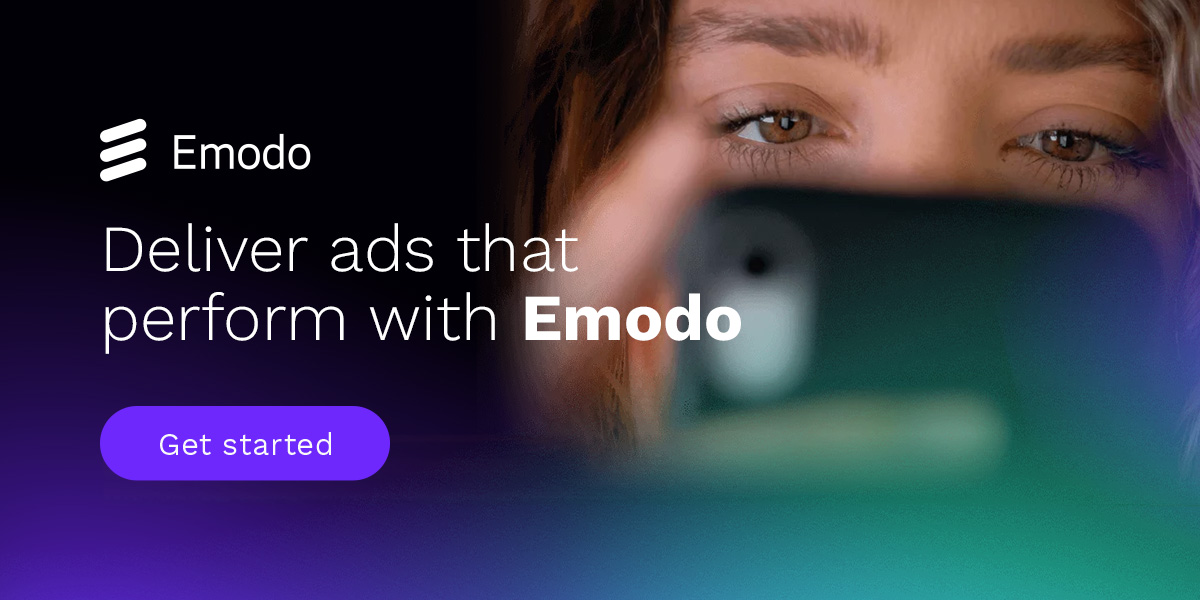Adtech is constantly evolving, and so are the expectations viewers have for the creative they see. Audiences want more engaging content that speaks to their wants and needs, and display ads alone just don’t do that anymore.
Enter rich media. This advanced technology enables you to bring your creativity to life for your viewer by including them in the experience. And since it’s still a new form of advertising, there’s still time to get ahead of your competition by making memorable rich media content.
What Is rich media?
Rich media is an innovative form of digital advertising that incorporates interactive elements into your creative. Unlike traditional animated banner ads, users can directly engage with the content in rich media ads without leaving the page or app they’re using.
Here’s an example. You’re between levels in a mobile game when a full-screen ad for an upcoming musical appears. When you tap on the ad’s CTA, your phone pulls up your navigation app and provides a route to the theater where the show will be playing. However, you never switched apps — you’re still in the game. That’s the magic of rich media.
3 Rich media advertising examples
You can do almost anything with rich media — there are too many possibilities to name in just one post! Here are just a few examples of what rich media content can look like.
1. Interactive shoppable ads
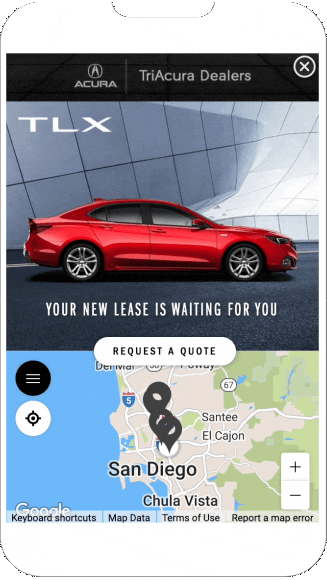
Shoppable creative allows you to see the impact of your ads in real time by enabling users to shop your brand directly from the ad.
Here’s how it works. When viewers tap on the product in the image or video, an integrated screen pops up within the app that lets them learn more about the product. More advanced versions of this ad will allow users to purchase items without ever leaving the original app they were in.
2. Interactive tap-to-map
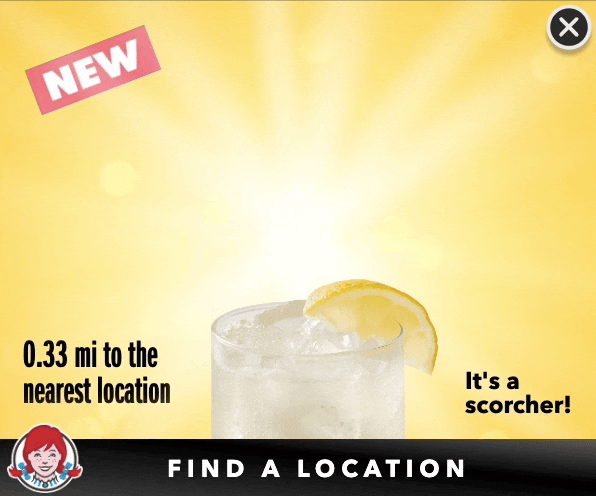
If you want to bring users to your physical location, you’ll want to consider using a tap-to-map ad. Your ad features an actionable button that sends the user directly to their phone’s native maps app from your ad.
For example, a tap-to-map ad for an upcoming concert might prompt users to tap for directions to the venue. When the user taps the button, their maps app opens with the venue’s address already loaded in the search bar.
3. Interactive videos
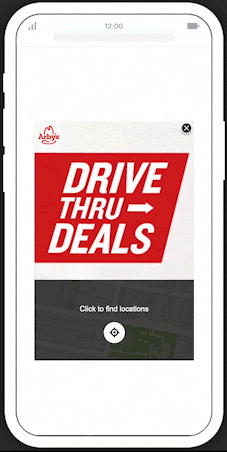
If you want to maximize your reach, video is one of the best ways to do it. Video is one of the most popular forms of media out there — the number of digital video viewers worldwide is projected to reach 3.48 billion by the end of 2023.
It works by applying an interactive overlay on top of the video while it’s playing. If the user wants to learn more about your brand, they can tap the appropriate button and be taken to your YouTube channel, their native app store or another destination.
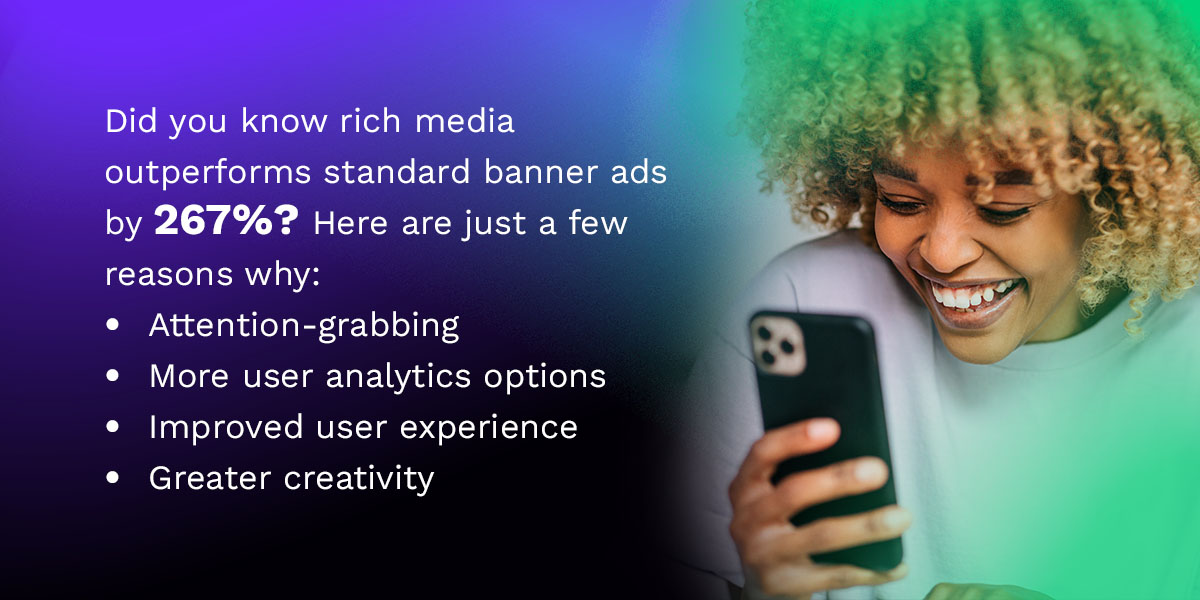
Why marketers should consider rich media ads
Did you know rich media outperforms standard banner ads by 267%? Here are just a few reasons why:
- Attention-grabbing: Because consumers are so used to standard banner ads, they often ignore them completely. Rich media is a new format that intrigues viewers, which is one of the reasons why it’s so good at catching the viewer’s eye.
- More user analytics options: With static display ads, you can only monitor performance through your click-through rate (CTR). Rich media ads offer more metrics for analysis, which can help you improve performance in future ad campaigns.
- Improved user experience: Viewers can interact with rich media ads without needing to leave the site they’re on, which helps create a frictionless experience for mobile users. Plus, publishers and site owners benefit from continued site traffic.
- Greater creativity: Rich media expands the limits of what’s possible with advertising by bringing the audience directly into the experience. You can use images, video, audio and even games to bring your creative to life.
How to create rich media ads
Want to build powerful creative for your next campaign? Here’s a quick list of best practices for developing impactful rich media content.
Consider your audience
As with any other type of ad, you need to consider what content will appeal to your target audience. Who’s going to be seeing your creative, and what reels them in? Will they be entertained by interactive augmented reality experiences, or do they need something more conventional? Answering these questions is essential for designing creative that lands.
Choose the right format
When you’re telling a story, you want to use the right medium. For example, you could choose to make a film, play, novel or podcast. The same goes for rich media ads. Depending on the nature of the advertisement, your target audience and your chosen medium, your best option might be totally different.
Some common examples of rich media ad formats include:
- Interstitial: Full-screen ads that appear at natural transition points in mobile apps — for example, an interstitial ad might appear between levels in a mobile game.
- Floating ads: Also known as overlay ads, floating ads move around the user’s screen with eye-catching animations.
- Expandable: These ads begin as small teasers on the screen and expand when the user taps on them. Because they’re relatively unintrusive, they’re perfect for mobile applications where screen space is limited.
- Push down: These are a type of expandable ad that pushes the rest of the page down when the creative expands.
- Dynamic creative: This format lets you adapt your creative to individual audiences based on dynamic parameters like date and time, weather, language and geographical location.
Make it interactive
The interactive element is the biggest draw for rich media ads — which is why it needs to be your number one priority in designing your ad. Consider how you can draw the viewer into the experience.
Let’s say you’re creating an interactive video ad for a shoe company. You could add a link to each product featured in the video that viewers could tap to learn more or add them to their cart. Or you could tell a viewer-controlled story where the main character wears your shoes. There truly is no limit to creativity here.
Follow app limits
Rich media ads are complex, which is why they’re much larger files than traditional display and banner ads. Ads that are too big or too complicated for the app can negatively impact ad and app performance, which can lead to dissatisfied viewers. If you want to incorporate your ad into a mobile app successfully, try to keep it within the app’s file size limit.
Work with a creative services partner
It can be tough to figure out where to start when you’re first breaking into rich media ads. That’s why it helps to get a second opinion from a reliable creative services provider like Emodo.
We can help you develop attention-grabbing rich media ads that connect with your audiences on a deeper level. Our contextual audiences technology builds detailed audience profiles without collecting sensitive user data, so you can track audiences even after third-party cookies have officially died. And our Emodo ad technology suite offers shoppable and tap-to-map ads you can use to boost the impact of your mobile campaigns.
Deliver ads that perform with Emodo
Rich media is revolutionizing mobile advertising, and getting on the trend now is vital for getting ahead of your competition. That’s why we’re here. Emodo Adapt, our adtech offering, helps advertisers and digital media planners create breathtaking experiences that speak to their audiences. With us, you’ll make creative your audience will truly feel. Contact us today to discover what’s possible.
MORE LIKE THIS
